Menus
- Upgrading
- Unchanged since 2012, the Yamaha 450 WRF has this time been completely revisited. Derived from the excellent YZF cross model, this new Yamaha enduro was designed as a racing machine capable of scratching right out of the box, even if it also knows how to be conciliatory. It is still…
- "Devilishly well designed"
- "Baja" mode
- On a hike
- To attack
- Conclusion
Upgrading
Unchanged since 2012, the Yamaha 450 WRF has this time been completely revisited. Derived from the excellent YZF cross model, this new Yamaha enduro was designed as a racing machine capable of scratching right out of the box, even if it also knows how to be conciliatory. It is still better to have a good technical background to get the most out of it.
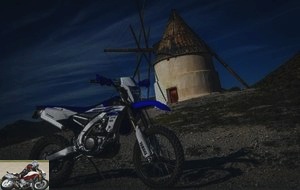
The Yamaha 450 WRF is quite simply an institution. Because before being a 450, the 400 cm3 released in 1998 under this name changed the face of off-roading by imposing a new standard of modern 4-T, in a world where the 2-T was then thought to be unbeatable. Having become 426 in 2001 then 450 in 2007, with the transition to the aluminum frame, the models have obviously followed one another with more or less success, with a last version dated 2012 which had somewhat left observers and fans of the mark on their hunger, despite the arrival of the injection in place of the obsolete carburetor. A little too heavy, high, not necessarily very fun in terms of engine, it was far from arousing the interest and passion of the illustrious models that had preceded it, even with the versions prepared for the Dakar rally, despite a Red award. Dowry. For a manufacturer as sportingly involved and technically advanced as Yamaha, it was therefore high time to react..

And that’s what they did, by applying to the letter the same plan as for the 250 WRF presented last year: we take as a basis the excellent cross model, MXGP world champion in the hands by Romain Febvre, with its reverse engine, then we adapt it to the specificities of the enduro market and voila. Easier said than done, moreover, because there is work to be done to move from the constraints of motocross circuits to those of an enduro machine, which must be able to be both agile in Limousin trails, to stay perfectly in line in the main straights of African rallies or to absorb the bumps of the Californian desert. Not easy. We feel that the affair is a story of compromise.
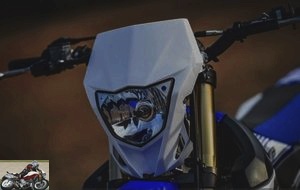
"Devilishly well designed"
“Rightfully wrong,” is the concept of Yamaha’s four-valve, double-overhead camshaft reverse engine. What we could roughly translate as "we are right to be wrong", but the thinking heads of French marketing have baptized "devilishly well designed". Already seen at the beginning of 2000 on the fire Cannondale 400 MX, it is in fact a question of completely rethinking the engine architecture, with an admission which is done at the front. The exhaust, meanwhile, exits through the rear of the engine, with an exhaust elbow that goes around the cylinder. The idea is to optimize the air supply as well as the extraction of the burnt gases, thanks to better combustion, while improving the centering of the masses, since the tank is placed under the saddle, therefore in an on position. can no longer central.
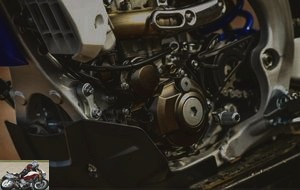
Another theoretical advantage of the system, the air filter is placed in the usual place of the tank, between the end of the saddle and the steering column and therefore much less exposed to dust than under the saddle. The muffler, which winds around the cylinder, thus gains in length compared to a "classic" architecture and is supposed to produce more torque. The refocusing of the masses towards the bottom is also at the heart of the subject, the tank not making deadweight in height as on a "normal" machine..
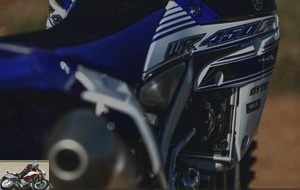
So far, we remain on the common with the cross model. To make it a real enduro, of course, Yamaha started with the basics: the adoption of the essential electric starter, in front of the cylinder, with a contactor integrated into the start button, which greatly facilitates life. Self-decompression occurs when the electric start is activated to facilitate engine cranking. In addition, the air supply to the block can be increased by 40% for reliable cold starting. The WR450F however remains equipped with a kickstarter, to make it possible to crack the mill in all circumstances, in particular in the event of failure of battery. The injection system has also been reprogrammed to meet endurance constraints. The throttle body, 42 mm on the WRF 2015, gains here two millimeters. The spray angle has also been revised to improve ease of use compared to the cross model, which favors maximum power where enduro requires more flexibility..
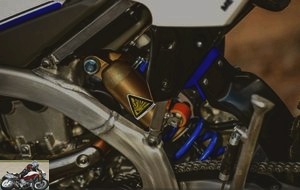
Another major element, the gearbox. With five speeds, it benefits from a slightly different ratio compared to the previous model. So if the first and fifth don’t change, second, third, and fourth are longer. The clutch has also been revised, with different materials used for the friction discs, a cable that goes from 2 to 2.5 mm and a new specific lever. The idea is to have a more flexible lever to operate while enjoying a smoother feeling in action. The radiators have a different angle than the cross model, and, above all, adopt a fan to improve cooling, especially in technical portions where the radiators receive little air. The integration of the fan led engineers to discreetly change the shape of the radiator vents, which are more enveloping. Finally, there is a small dashboard with speedometer and a handy reserve indicator to complete this enduro range, not to mention the essential 18-inch rear wheel, fitted with Metzeler 6 Days Extreme tires..
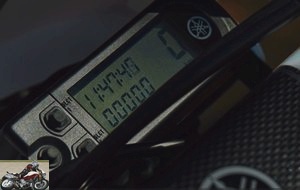
To be complete, let us add that for the specific conditions of this test, our wheels were fitted with foams instead of the usual air chambers and Acerbis hand guards were installed to prevent us from stupidly fracturing our finger with a bad stone…
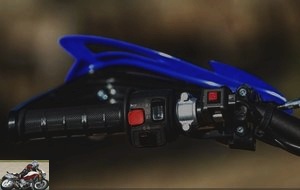
"Baja" mode
Since we discuss the conditions of the test, they were specific. Yamaha Europe has indeed invited the European press to the south of Spain, to Almeria, for a "Baja" style ride, which is therefore rather quick. About two hundred kilometers of tracks which have thus allowed to get a fairly precise idea of the motorcycle, even if this type of driving is at the very least far from the practice as we know it in France but perfectly corresponds to the philosophy. of the WRF.
The first thing that strikes you when you get on the machine is the important saddle height, since it culminates at 965 mm according to the technical sheet. Better to exceed 170 cm to be able to easily set foot on the ground, therefore. Once perched up there, you quickly feel at home, with a welcoming saddle and, above all, very flat, which makes it easier to move around on this saddle..
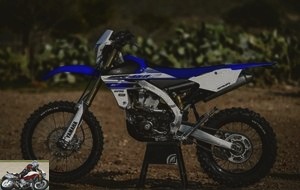
The handlebars, which are also very flat, seem pleasant at first glance. It should also be noted in this regard that we have four possibilities to change the position of the handlebars on the tee, which should allow with a little testing to find a setting perfectly suited to each morphology. The controls are at the Japanese standard, by which means that everything falls exactly where it is needed. The Yamaha 450, like its little sister 250, has the particularity of having large radiator gills, which is a little inconvenient at the start at the level of the knees. But, in all honesty, we quickly forget this detail after a few kilometers behind the handlebars..
On a hike
A little pressure on the black button which serves as a contactor and the unit snorts in relative discretion thanks to the enormous aluminum silencer. At the beginning. Because once on the track, it is not necessarily the same. The sound of the air being sucked in, just below the pilot’s head, quickly breaks your ears, it must be admitted. So, on a long hike, we cannot recommend too much to wear earplugs. The advantage is that it paradoxically does not appear too noisy to residents that we may pass, which is already not so bad.
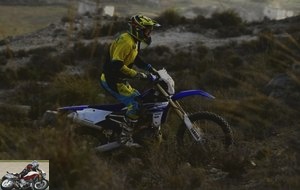
From the first paths, we realize the gain in handling compared to the old model, which the high weight made difficult to maneuver in the technique. Here, it is undoubtedly easier, thanks to a center of gravity that we feel placed lower, even if it is still far from being the most manoeuvrable of the 450 in its category, far from it. As you warm up, confidence comes naturally. Engine braking is certainly present, but more like an ally than an enemy and never turns out to be a handicap. Braking, provided by a 270 mm disc at the front and a 245 mm at the rear, is above all suspicion: efficient, easy to dose and enduring. A faultless.
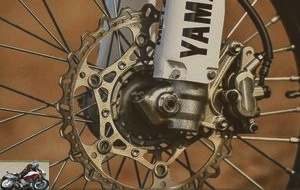
Another good news is a pair of KYB suspensions that do the job with panache. Indeed, the fork as the shock absorber have an original setting rather well thought out for a pilot of average size. The fork digs in correctly on the first third of the race, allowing the front end to be registered well in the turns, while being firm on the last two thirds or rapid compressions. In fact, it can withstand big shocks that we would not have anticipated, for example. We can attest to that! What is more, it works in perfect harmony with the shock absorber, which reacts in a similar way. Offering good grip on exiting a turn or in the few climbs that we have crossed, the latter never makes a mistake in the event of a bad encounter with a stone or other mishap that does not fail to happen on a ride like this one.

And what stability from the chassis! We know that off-road Yamaha regularly pride themselves on being among the most stable on the market and we can only note that this is once again the case with this WRF. Even at speeds close to 120/130 km / h or even more on the (wide) Andalusian paths, the bike goes straight in all circumstances, providing a feeling of absolute safety that few other machines could boast. And believe that at these speeds, it is very appreciable !
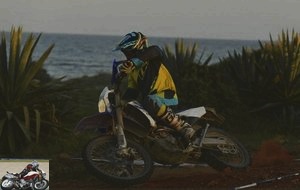
It remains to address the theme of the engine … An engine that we know particularly explosive in cross version. Well even if he has indeed been calmed down for this enduro livery, we can assure you that he has not lost much in terms of character. Do not go four ways: it is severe! Even with the standard injection mapping, it is advisable to handle the right grip with care to avoid getting knocked off or losing grip so much it sends.
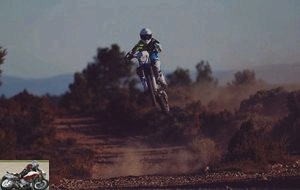
In quiet hikes or on tracks like those of the test, it’s fun. You can easily send glides under acceleration or do everything to reach unspeakable speeds when a straight line presents itself. But inevitably, the medal has a big setback. Because when it comes to approaching more technical parts, it is better to have a certain skill or suffer severe.
However, there are solutions to calm the ardor of the bloc. We took advantage of the lunch break to change the mapping, by switching to the softer one, thanks to the Power Tuner tool, a small electronic box to be connected directly to the motorcycle. Which, indeed, manages to make the engine much less explosive, especially at low revs and therefore easier to operate. The climbs in the towers remain sturdy, but are done in a more linear way than with the standard, which literally kicks you in the buttocks..

A word on the box, to say that it is very efficient and easy to operate. The gears shift impeccably and are rather well staged, even if, with such a torque, one may well wonder what is the point of the first if not to wander in the paddock. Another reason for satisfaction is the clutch. Gentle, precise, efficient and enduring, it elicited nothing but praise.
To attack
With a guide for the day, Frans Verhoeven, capable of winning stages in the Dakar rally, the pleasant ride sometimes took on the appearance of a special. A good opportunity to push the machine and the guy to its limits. There, no doubt, the Yam is in its element.

Whether the injection map is on standard, soft or hard, the power reserve is there without problem. It’s all just a question of physics or risk taking! In the fast, the WRF is simply royal. The quality of the suspensions already mentioned and the engine response make it a weapon with infinite potential. It remains for the pilot to master it, this potential, because when attacking, believe that the turns literally jump in your face. !
So much so that we came close to missing one, a corner … Yamaha also had the good taste to draw us three different small stages to assess the beautiful in different conditions. One extreme, one cross test and one line.
In the extreme, we feel that a bit of maneuverability in addition would not be refused. In tight turns, you have to pull out your muscles to position the machine right where you want it and be particularly attentive to revivals with the throttle, even when moving at a higher speed to calm it down. Despite everything, she knows how to do it, but once again, it is better to have a solid background in terms of piloting..
In the cross test and its large supports of dust worthy of the fesh-fesh of the Dakar, it is perfectly in its element: a big blow of clutch and it propels you towards the next curve, not without having smashed the support! Same observation in the fast line, where the Yam was able to appreciate its stability and the quality of its suspensions in the long straight lines filled with vicious stones hidden under the thin layer of sand..
In short, as much to tell you that she is more at ease there than in the extreme, it is obvious. We would have liked to test it a bit in crossing, unfortunately the terrain did not lend itself to it. However, we can already predict that it will not be his favorite terrain either without going too far….
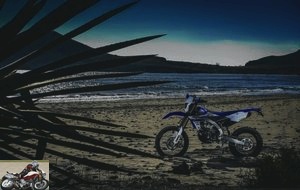
Conclusion
We’ve come a long way, since the 1998 Yamaha 400 WRF which revolutionized the 4-T enduro market. However, this 2016 WRF remains in the same vein: a motorcycle designed for performance and the great outdoors. Certainly, it is able to evolve in a quiet hiking mode as long as we put the mapping that goes well. But that’s not what it’s predestined for, which is to drive fast. Whether in the Californian desert or on the Baja tracks of Andalusia, fast is its favorite terrain. And it excels at it, thanks to the combination of several factors. In the first place, this famous engine with inverted architecture which proves to be demonic to take when it has the place to express itself. What a pleasure, indeed, to increase the speeds on the fly to afford peaks between two curves to be linked in gliding. And then there is also this great chassis which allows to exploit the block to the maximum, thanks first of all to a stability difficult to fault and suspensions which stick perfectly to the philosophy of the machine. Not easy, obviously, to advise this bike if your practice consists of riding in the trialisant without spending the second part of the day. On the other hand, if you are the type to go spreading on the tracks of Morocco or if you want to taste the joys of easy long-distance hiking, there is no doubt that this Yamaha will seduce you, especially as its finish is always so neat. . One thing is certain: it gives sensations. And in the world as we know it today, this is already very good. At 9,599 € the end, we can not say that it is a good deal, even if it is in the standard for a 450 enduro.
Strong points
- Demonic Engine
- Securing frame
- Efficient suspensions
- Possibility to adjust the mapping with the Power Tuner
Weak points
- Improved handling
- Imposing template
The WR450F technical sheet
Related articles
-
3 cylinders, 847 cm3, 115 hp, 8.9 m / kg, 195 kilos, € 12,599 A limited series of 695 pieces in collaboration with Abarth October 2007: Valentino Rossi…
-
Immediate pleasure ! Twin-cylinder CP2 of 689 cm3, 74.8 hp and 68 Nm, 188 kg full made, 8,799 € Halfway between a small compact roadster and a scrambler,…
-
Winning return To those who doubted the involvement of Yamaha in enduro, despite its rich history and success, the new 250 WR-F opposes an end of…
-
200 hp at 13,500 rpm, 112 N.m at 11,500 rpm, 199 kilos with full fuel, from € 18,499 Is the Crossplane engine an advantage in road use ? Even if the…
-
Yamaha TMax 560 TechMax maxi-scooter test
Standard vs TechMax: which model to choose ? Twin cylinder of 562 cm3, 47.6 hp and 55.7 Nm, 218 kg, from 11,990 euros 7th generation! Yes the Yamaha TMax…
-
Alone in the world Single cylinder VVA of 124 cm3, 15 hp and 11.5 Nm, 140 kg full made, 4,599 euros Today, when you want to ride a vintage / retro /…
-
Test Yamaha XTZ 750 Super Tenere
Twin-cylinder in-line, 749 cm3, 70 hp, 6.8 m / kg, 195 kilos dry, from € 1,000 Produced from 1989 to 1995, this big and reliable road trail smells of…
-
V2, 942 cm3, 54 hp, 81 Nm, 252 kilos, € 9,999 A scrambler made on the basis of the XV 950 customs Free your chains! Yes, refuse conformism, finally…
-
Yamaha Tracer 700 motorcycle test
Sport touring or the modern day SUV Don’t call me trail anymore! Call me sport touring! And here are all the certainties which disappear on all these new…
-
The dark side of the A2 Who remembers the first Yamaha MT-03 by the name in 2006? From the beginning of the MT but under the banner of the Master of…